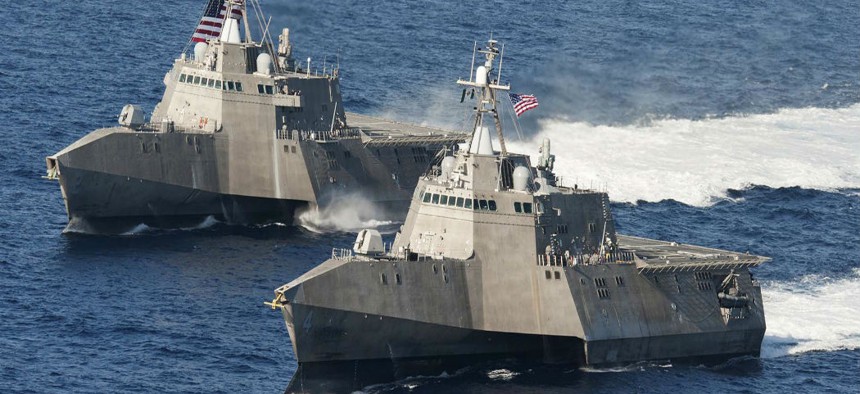Navy pursues lightweight LCS sonar, sensors
Lighter weight sonar for the Littoral Combat Ship will better enable submarine hunting at greater distances.
The Navy is developing lighter weight anti-submarine technology designed to improve the Littoral Combat Ship’s ability to track, locate and destroy enemy submarines.
The idea is to harness lighter variable depth sonar (VDS) and AN/SQR-20 Multi-Function Towed Array (MFTA) systems, along with other anti-submarine technologies, to enable the LCS to receive acoustic signals from enemy subs in different maritime conditions and at greater distances.
“We were able to get submarine detections at long ranges,” Capt. Casey Moton, LCS Mission Module Program Manager said in an interview several months ago.
The Navy has awarded three developmental contracts to industry as part of this initiative to engineer more effective and functional systems for the LCS.
“We will go forward with one, two or three of them, do additional design work and then based on that effort we are going to build an engineering development model and also have the weight reduction,” Moton said. The plan right now it we'll start testing at the end of 17 and go into operational testing and IOC [initial operating capability] in 2018.”
The VDS and MFTA scan for acoustic signals and frequencies consistent with an enemy submarine; information is then relayed back up to an on-board LCS command center.
“They listen for a continuous active ping. Then you wait for a period of time and there is another ping. This enables us to track the submarine and we get that energy back on the passive towed array. That system was very effective for long-range submarine detection,” Moton said.
Lighter weight submarine hunting tools are of particular importance to the LCS because the ship relies upon speed and maneuverability for increased combat performance.
The VDS is engineered to travel beneath a thermal layer in the ocean where the temperature stops changing -- the layer can act as an acoustic boundary, Moton said.
The LCS’ anti-submarine package also includes an MH-60 sub-hunting helicopter equipped with lightweight torpedoes and sonobuoys to search for acoustic signals from enemy submarines. A helicopter-like drone scans the ocean for enemy activity and sends back real-time video images through a data link.
Ultimately, the Navy plans to replace current commercial off-the-shelf VDS and MFTA systems with lighter weight developmental models, Moton said.
“We are making an improvement in how we operate our sonar. Signals will be received by the towed array, data will be given to a helicopter and then the helicopter will fly out and use its own sonar and sonobuoys to locate a submarine and drop a weapon,” Moton said.
An advanced computer system on board the LCS is designed to integrate incoming sonar and targeting information from underwater assets and helicopters, helping to acquire and relay combat relevant data. As part of this effort, the LCS is connected via a data link to the Navy’s P-8 sub-hunting aircraft.
This anti-submarine developmental effort is progressing alongside a broader effort to up-gun the LCS with improved weapons and survivability technology. The idea is to better enable a littoral vessel to perform missions in higher threat environments while being less vulnerable to attacks from enemy submarines. With longer range, more high-tech sonar on board, LCS could locate, and potentially avoid, enemy subs.
This story was also published in Scout Warrior.




